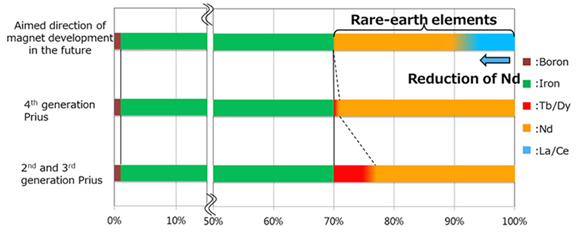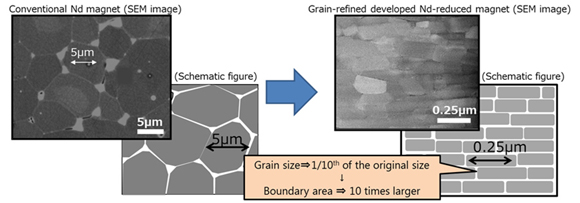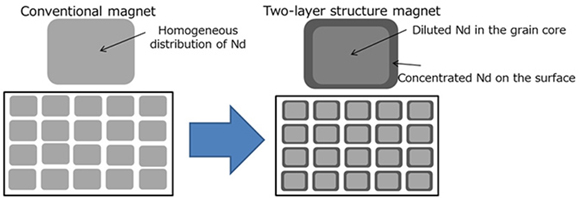Toyota develops neodymium reduced-rare earth magnet for electric motors
March 1, 2018
Toyota Motor Corporation, Toyota City, Japan, has developed what it states is the world’s first neodymium-reduced, heat-resistant magnet. Neodymium (Nd) magnets are used in a variety of motors, including high-output motors found in electrified vehicles. According to Toyota, the new magnet uses significantly less of the rare-earth element neodymium and can be used in high-temperature conditions.
It is important that magnets used in automotive motors and other applications have high coercivity (the ability to maintain magnetisation) even at high temperatures. For this reason, approximately 30% of the elements used in magnets are rare earths. The rare earths terbium (Tb) and dysprosium (Dy) are generally added to Nd magnets to increase high-temperature coercivity. However, these metals are rare and expensive and are found in high-geopolitical risk locations. Because of this, Toyota stated that it has made considerable efforts to develop magnets that do not use these metals – the newly developed magnet is said to use no Tb or Dy at all.
Although production volumes of neodymium are relatively high among rare earths, there are concerns that shortages will develop as electrified vehicles, including hybrid and battery electric vehicles, become increasingly popular. Therefore, a portion of the Nd in the magnet has also been replaced with lanthanum (La) and cerium (Ce), said to be lower-cost rare earths.
According to Toyota, merely reducing the Nd and replacing it with La and Ce results in a decline in motor performance; as a result, the company states that it has adopted new technologies to suppress the deterioration of coercivity and heat resistance and developed a magnet with levels of heat resistance equivalent to typical Nd magnets, while reducing the amount of Nd used by up to 50%.

This new type of magnet is expected to be useful in expanding the use of electric motors in areas such as automobiles and robotics, as well as maintaining a balance between the supply and demand of valuable rare earth resources. Toyota stated that it plans to work on further enhancing the performance of the magnets and evaluate their application in products, while accelerating the development of mass production technologies.
Key development features
According to Toyota, its new Nd-reduced magnet is able to maintain coercivity even at high temperatures thanks to the combination of three new technologies:
1. Grain refinement of the magnet
2. Two-layered high-performance grain surface
3. Specific alloying ratio of lanthanum and cerium
1. Grain refinement of magnet
Toyota stated that it is now possible to retain high coercivity at high temperatures through the reduction of the size of the magnet grains to 10% or less of those found in conventional Nd magnets and an enlargement of the grain boundary area.

2. Two-layered high-performance grain surface
In a conventional Nd magnet, neodymium is spread evenly within the grains of the magnet, and in many cases, Toyota stated that the neodymium used is more than the necessary amount to maintain coercivity.
Thus, it is possible to use Nd more efficiently by increasing the neodymium concentration on the surface of the magnet grains, which is necessary to increase coercivity, and decreasing the concentration in the grain core. This results in the reduction of the overall amount of neodymium used in the new magnet.

3. Specific ratio of lanthanum and cerium
If neodymium is simply alloyed with lanthanum and cerium, its performance properties (heat resistance and coercivity) decline substantially, complicating the use of light rare earths. After evaluating various alloys, Toyota stated that it discovered a specific ratio at which La and Ce can be alloyed so that the deterioration of properties is suppressed.

Future efforts in Nd-reduced magnets at Toyota
Toyota stated that the continued development of elemental technologies for motors, inverters, batteries and other components will require steady research and development and that it sees these technologies as essential for the increased adoption of electrified vehicles.
This new magnet is expected to be put into use in electric power steering motors for automobiles and other applications in the first half of the 2020s. The company believes that it will have a wide range of applications in motors that require relatively high output, such as those required for electrified vehicle drive motors and generators, robots and various household appliances, as well as helping to reduce the risks posed by potential disruptions in rare earth supplies and price increases.
Going forward, the company reported that it will proceed with further practical applications in mind, perform application assessments in motor vehicles and continue researching and developing technologies with the aim of achieving low-cost, stable production.















